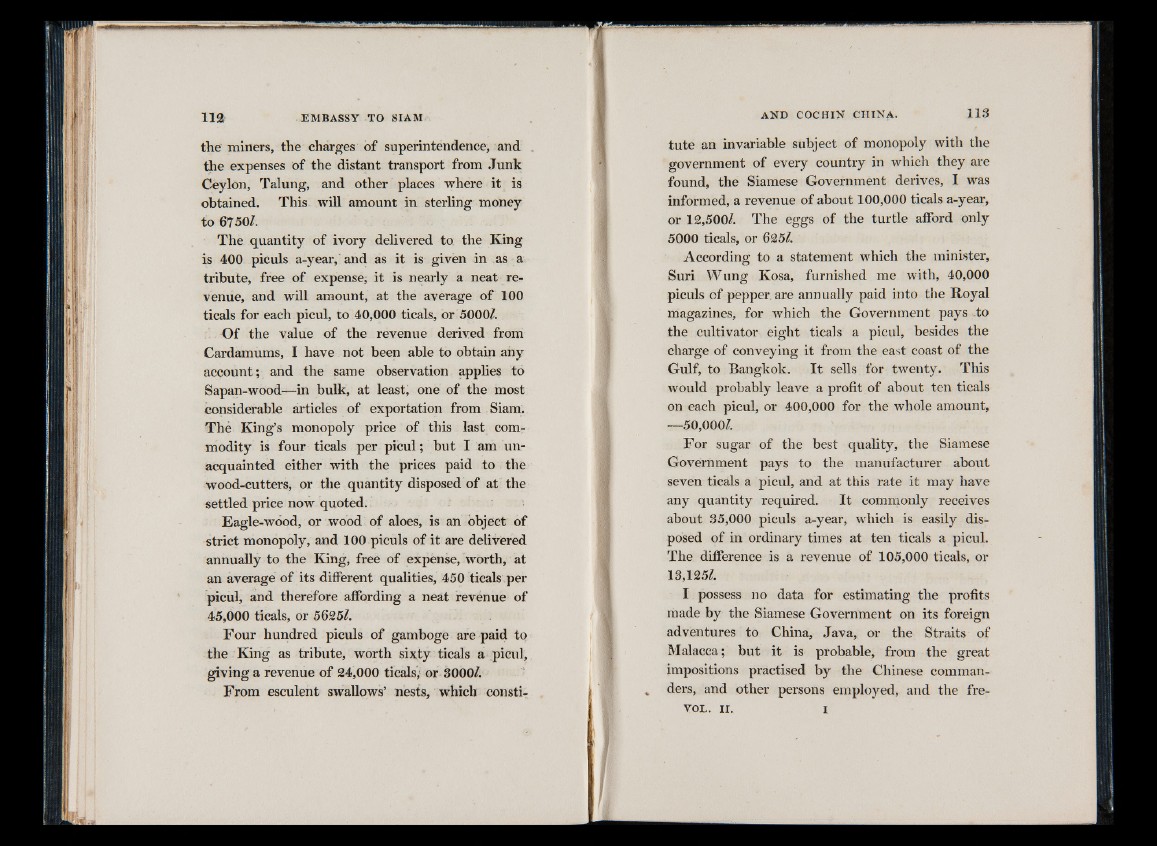
the miners, the charges of superintendence, and
the expenses of the distant transport from Junk
Ceylon, Talung, and other places where it is
obtained. This will amount in sterling money
to 67501.
The quantity of ivory delivered to the King
is 400 piculs a-year,' and as it is given in as a
tribute, free of expense,- it is nearly a neat revenue,
and will amount, at the average of 100
ticals for each picul, to 40,000 ticals, or5000/.
Of the value of the revenue derived from
Cardamums, I have not been able to obtain any
account; and the same observation applies to
Sapan-wood—in bulk, at least, one of the most
considerable articles of exportation from Siam,
Thé King’s monopoly price of this last commodity
is four ticals per picul ; but I am unacquainted
either with the prices paid to the
woòd-cutters, or the quantity disposed of at the
settled price now quoted.
Eagle-wood, or wood of aloes, is an object of
strict monopoly, and 100 piculs of it are delivered
annually to the King, free of expense, worth, at
an average of its different qualities, 450 ticals per
picul, and therefore affording a neat revenue of
45,000 ticals, or 56251.
Four hundred piculs of gamboge are paid to
the King as tribute, worth sixty ticals a picul,
giving a revenue of 24,000 ticals,1 or 3000/.
From esculent swallows’ nests, which constitute
an invariable subject of monopoly with the
government of every country in which they are
found, the Siamese Government derives, I was
informed, a revenue of about 100,000 ticals a-year,
or 12,500/. The eggs of the turtle afford only
5000 ticals, or 625/.
According to a statement which the minister,
Suri Wung Kosa, furnished me with, 40,000
piculs of pepper, are annually paid into the Royal
magazines, for which the Government pays -to
the cultivator eight ticals a picul, besides the
charge of conveying it from the east coast of the
Gulf, to Bangkok. I t sells for twenty. This
would probably leave a profit of about ten ticals
on each picul, or 400,000 for the whole amount,
—50,000/.
For sugar of the best quality, the Siamese
Government pays to the manufacturer about
seven ticals a picul, and at this rate it may have
any quantity required. I t commonly receives
about 35,000 piculs a-year, which is easily disposed
of in ordinary times at ten ticals a picul.
The difference is a revenue of 105,000 ticals, or
13,125/.
I possess no data for estimating the profits
made by the Siamese Government on its foreign
adventures to China, Java, or the Straits of
Malacca; but it is probable, from the great
impositions practised by the Chinese commanders,
and other persons employed, and the fre-
VOL. II. i